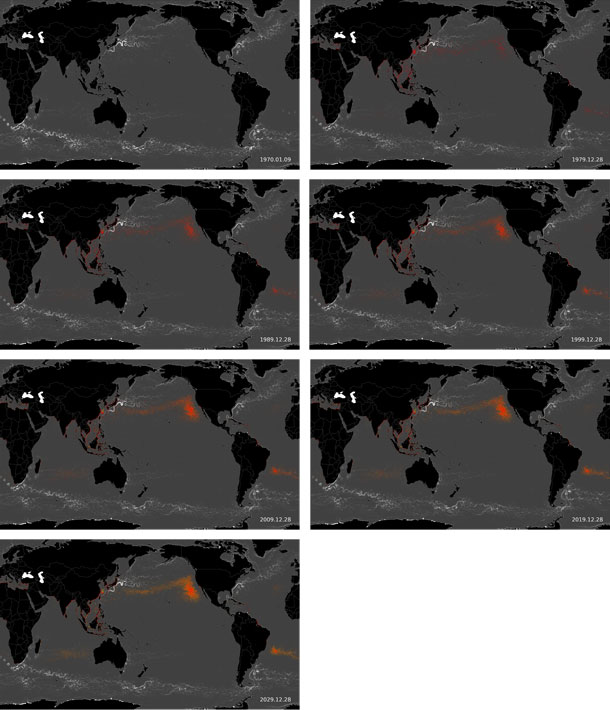地球全球の海流と、浮遊、沈降するごみのシミュレーション映像
海洋研究開発機構(JAMSTEC)で開発された海洋循環モデル(OFES)を用いて全球の海の流れを数値シミュレーションで再現。その「海」に、陸起源のプラスチックを模した粒子を流している。粒子の投入場所と投入量は、科学雑誌サイエンスに掲載の文献を参照した(Jambeck et al. 2005)。このシミュレーションでは、日本南岸を流れる黒潮の躍動的な変化や、細かな渦の生成と複雑な挙動が捉えられている。河川を通して陸から海に流入したプラスチックは、こうしたダイナミックな流れに乗りながらも、広い大洋に巨大なゴミの集積帯(Gabage patch)を形成する。その領域に到達したプラスチックは、そのまま漂い続けるか、沈む運命にあり、陸に戻ることはない。この映像作品では、漂流中の粒子を赤色で、沈降した粒子を黄色で表示している。

協力:青木邦弘(JAMSTEC)
Numerical simulation of oceanic flows and
garbage drift and sinking during 1970-2069.
This work displays the particle drift representing plastic garbage on the global oceanic flows simulated by a numerical ocean circulation model (called OFES) developed by JAMSTEC. The place and amount of the garbage discharge are set following a paper in the journal, Science (Jambeck et al. 2015). This simulation reproduces a drastic fluctuations of Kuroshio current path south of Japan and complex behaviors of small scale oceanic eddies. The plastics flowed out to the ocean through rivers are drifted by such a dynamic oceanic flows and eventually form great garbage patch. The fate of those plastics are either staying there or sinking into the sea floor, but never returned to the land. This video work denotes a drift particle and sinking particle as red and yellow dots, respectively.

collaborate with Kunihiro Aoki (JAMSTEC)